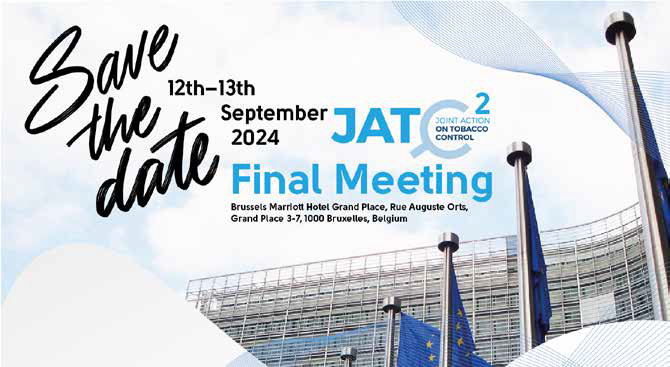Welcome to the summer update on the Joint Action on Tobacco Control 2!

RECENT DELIVERABLES
We are excited to share progress on several key deliverables that are driving our mission to improve public health across the European Union Member States (EU MS) through effective tobacco and nicotine product regulation and harmonized cross EU wide collaborations. Here’s a look at our recent work and recent achievements that cover aspects of product monitoring, regulation, smokefree areas and tobacco endgame:
1. EU-CEG data integration from MS-Rep to local databases at the national scale (Deliverable 5.2)
The EU-CEG (European Union Common Entry Gate) data management system continues to evolve, enhancing its capabilities for Member State Competent Authorities. From the EU MS perspective, MS-Rep consists in a web interface to search, browse, view, query and export data from the manufacturers’ electronic submissions about their products. To fulfill the many use cases the MSCA may have to process their data, MS-Rep comprises a report repository section where, inter alia, raw XML data can be downloaded. Every month, a new set of XML files relevant to the most recent submissions is made available by EC services under MS-Rep repository for both tobacco (TP) and e-cigarette (EC) products. The Submitter details (SUB) are also updated monthly. Those XML files collections are compressed into ZIP archive files for lighter storage and easier download.
This technical deliverable 5.2 describes a procedure that can be applied at the EU MS level:
1) to transform collections of EUCEG XML files (TP, EC and SUB) into sets of CSV files;
2) to import the latter CSV files into a Structured Query Language (SQL) database (DB) for further
handling and analysis.
The complete deliverable can be found at: https://jaotc.eu/wp-content/uploads/2024/07/D.5.2-EUCEG-
data-integration-from-MS-Rep-to-local-databases-at-national-scale.pdf
2. Dashboard and how-to guide to analyse EU-CEG data at national scale (Deliverable 5.4)
Deliverable 5.4 focuses on integrating EU-CEG submissions into local databases for national-scale analysis. The JATC2 5.4 deliverable describes a procedure to build local SQLite3 databases (DB) of EUCEG, which is essential for national-scale analysis of the information within EU-CEG.
It is important to note that the methodological approach outlined in the report is based on the use of external software, which is open source, free to use for the intended purpose, and available for download from the Internet, making this approach of added value to EU MS.
These tools will enhance local data analysis capabilities and support evidence-based decisionmaking as the script and syntax which is to be used for data analysis is provided within the report.
The complete deliverable can be found at: https://jaotc.eu/wp-content/uploads/2024/07/D.5.4.-Dashboard-and-how-to-guide-to-analyse-EU-CEG-data-at-national-scale.pdf
3. Report on regulation of novel tobacco products and e-cigarettes in different EU Member States (Deliverable 7.1)
The aim of this report is to provide an overview of the information on Member States’ specific legislation for novel tobacco products, e-cigarettes, and related products that fall outside the scope of novel tobacco products (herbal products for smoking are not included in this overview). In order to investigate the regulation of novel tobacco products and e-cigarettes between EU MS, a questionnaire was prepared and shared with contact persons from 25 EU MS and Norway
The report shows that, even when countries have implemented the TPD, many differences exist between MS in regulating these products. It is also important to note that all Member States provided information regarding actions taken against manufacturers and importers of novel tobacco products, e-cigarettes, and refill containers in case of non-compliance. Usually, the EU MS required product withdrawal and fines, followed by requirements for product modification/correction indicating the role of the EU MS in ensuring a harmonized approach.
The information in this report can raise awareness of these differences among EU regulators and public health researchers. In addition to the provided information, product use can be followed over time to identify best practices of product regulation in different EU MS.
The complete deliverable can be found at: https://jaotc.eu/wp-content/uploads/2023/10/D7.1-Report-on-regulation-of-novel-tobacco-products-and-e-cigarettes-in-different-EU-Member-States.pdf
4. Report on relevant health risks for novel tobacco products,e-cigarettes (Deliverable 7.3)
Deliverable 7.3 addresses health concerns related to e-cigarettes and heated tobacco products. The assessment in the report encompasses ingredients, additives, devices, and emissions and performs an initial categorization of these products based on their health risk potential. The main objective of the report is to investigate the health risk profiles associated with high-priority substances from electronic cigarettes and heated tobacco products, building on the previous JATC2 report from 2022, highlighting key factors contributing to health risks of e-cigarette use, such as substance mixtures, device characteristics and Do It Yourself (DIY) practices.
A total of 133 high-priority substances, including ingredients and emissions, underwent categorization based on various hazard criteria, including classifications such as human carcinogens, mutagens, reproductive toxicants, endocrine disruptors, toxicity for specific organs upon repeated exposure, respiratory sensitizers, or highly acutely toxic compounds. The analysis encompassed the frequency of declaration by manufacturers, ingredients concentration in products, and emission concentrations.
Out of the 133 substances, 107 were classified as carcinogenic, 32 as mutagenic, 20 as reprotoxic, 25 with chronic toxicity, 1 as a respiratory sensitizer, and 60 with endocrine disruptor potential.
The complete deliverable can be found at: https://jaotc.eu/wp-content/uploads/2024/06/D.7.3.-Report-on-relevant-health-risks-for-novel-tobacco-productse-cigarettes.pdf
5. Report on product use, familiarity and perceptions of novel tobacco products and e-cigarettes (Deliverable 7.4)
Within the scope of the 2nd Joint Action on Tobacco Control (JATC 2) and to accurately evaluate the health impact of novel tobacco products and electronic cigarettes, it is essential to gather information on product awareness, usage patterns, and public perception. The aim of this report was to investigate product awareness, use, and perceptions to provide recommendations to regulators on e-cigarettes and heated tobacco products.
Within this report, the assessment focused on electronic cigarettes and heated tobacco products with a research strategy that prioritized the use of Eurobarometer data when relevant and a review of available literature.
The report noted that both e-cigarettes and heated tobacco products exhibit close associations with polyuse of other tobacco products and smoking status. Socioeconomic factors play a role in usage patterns for both products while the perception of harm associated with these products is widespread, supported by evidence of harmful substances in emissions and extensive media coverage. While Europeans generally view e-cigarettes and HTPs as safer than traditional tobacco, opinions vary by country. There is a need for improved health literacy and targeted communication about regulations for both products. Growing support for regulations restricting the use of e cigarettes and HTPs in public places aligns with broader efforts to establish smoke-free environments.
The report also outlined that for future studies, a standardized questionnaire to obtain comparable data effective for a meta-analysis and to reduce heterogeneity between studies is needed. Furthermore, as the evolution of e-cigarette and HTP uses and perceptions is very rapid, more studies are needed, especially at a European level, to improve our knowledge of the spread of both products and their patterns of use.
The complete deliverable can be found at: https://jaotc.eu/wp-content/uploads/2024/06/D7.4.-Report-on-product-use-familiarity-and-perceptions-of-novel-tobacco-products-and-e-cigarettes.pdf
6. Position Paper for a new Tobacco Advertising Directive (Deliverable 8.3)
Advertising, promotion and sponsorship of tobacco and related products (TAPS) increase products’ use, especially initiation of use and progression to regular use. Comprehensive TAPS bans are effective measures resulting in reduced product consumption.
In the EU, there are currently important loopholes in TAPS regulation and citizens are not adequately protected from TAPS. This deliverable aims to identify the TAPS loopholes in the EU and propose necessary TAPS control measures based on the activities within Work Package 8 of the JATC-2, such as a comprehensive consultation with national experts and a systematic review of the literature.
The implementation of a comprehensive TAPS ban encompassing all products, marketing channels and existing loopholes in the regulations is necessary in the EU in order to protect the citizens from TAPS, especially youth, and decrease consumption of tobacco, related and nicotine products in EU. In light of the above, the Deliverable outlines 10 Key recommendations for a potential update of current TAPS regulation.
The complete deliverable can be found at: https://jaotc.eu/wp-content/uploads/2024/06/D-8.3-Position-paper-for-a-new-TAD.pdf
7. Recommendations for research on forward-looking tobacco control policies and tobacco endgame strategies (Deliverable 9.2)
Due to the continued detrimental effects of tobacco use, a growing number of countries are embracing the idea of tobacco endgame, meaning ending the tobacco epidemic instead of controlling it. Deliverable 9.2 aims to synthesize and update the evidence from earlier scientific reviews on effective tobacco endgame measures and assess their integration into current national strategies among European countries with official tobacco endgame goals.
The synthesis of the prior scientific literature found most evidence on product-focused and some evidence for supply-focused policies. Less to little evidence was detected for user- and institutionalfocused measures. An update for the tobacco-free generation measure showed uncertainty in reducing smoking prevalence, especially for adolescents’ reactions to age-restrictive laws. All the countries that established a tobacco endgame strategy have included product standards in their measures, predominantly based on European Union regulations on conventional tobacco products. Yet, standards above this level and considering other products were also common. Cessation measures were given strong emphasis in strategies, yet none of the countries linked these to specific endgame measures. Despite commonly mentioning vulnerable groups, such as youth and pregnant women, the adoption of measures to reduce tobacco use among these groups was scarce. Lastly, the tobacco use decline seems modest, implying challenges in meeting the endgame goals. To meet these goals, European countries should reinforce the implementation of known effective tobacco control measures such as tax increases. Furthermore, new innovative strategies and measures to meet the objective of an endgame should be explored.
The complete deliverable can be found at: https://jaotc.eu/wp-content/uploads/2024/06/D-9.2-Recommendations-for-research-on-forward-looking-tobacco-control-policies-and-tobaccoendgame-strategies.pdf

